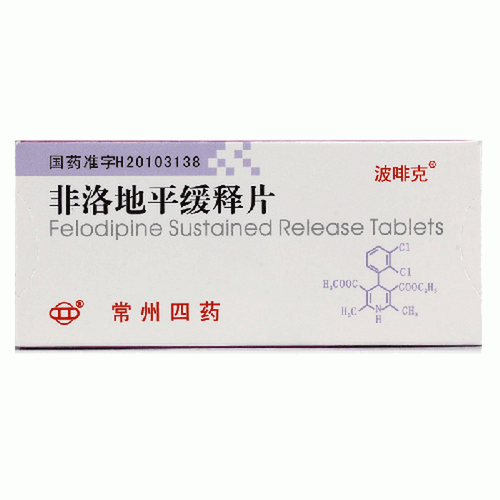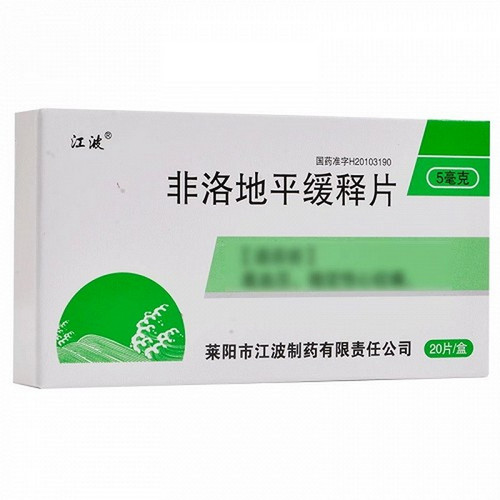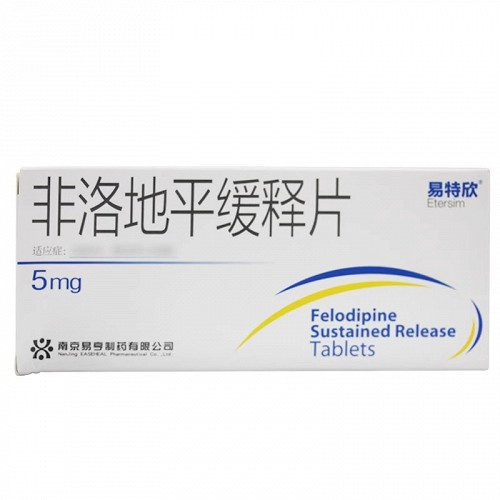Product Overview
[Drug Name]
Generic Name: Felodipine Sustained-Release Tablets
Trade Name: Felodipine
English Name: Felodipine Sustained-Release Tablets
Chinese Pinyin: Feiluodiping Huanshipian
[Ingredients]
The active ingredient is felodipine. Chemical Name: 2,6-Dimethyl-4-(2,3-dichlorophenyl)-1,4-dihydro-3,5-pyridinedicarboxylic acid methyl ethyl ester. Molecular Weight: C18H19Cl2NO4
[Properties]
This product is a film-coated tablet that appears white or off-white after removal of the film coating.
[Indications]
Hypertension (can be used alone or in combination with other antihypertensive medications).
[Dosage and Administration]
Oral administration; dosage should be individualized. The tablet should be taken in the morning with water. Do not break, crush, or chew the tablet. For the treatment of hypertension: The recommended starting dose is 5 mg once daily. The usual maintenance dose is 5 or 10 mg once daily. The dose may be reduced or increased, or other antihypertensive medications may be added, depending on the patient's response. Dosage adjustments should generally be made at least every two weeks. For some patients, such as the elderly and those with impaired liver function, 2.5 mg once daily may be sufficient. Doses exceeding 10 mg once daily are generally not necessary. For the treatment of angina pectoris: 5 mg once daily is recommended as the initial treatment dose, with a typical maintenance dose of 5 or 10 mg once daily. Caution should be exercised in patients with severe renal impairment.
[Adverse Reactions]
The most common adverse reaction to this drug is mild to moderate ankle edema, which is caused by peripheral vasodilation and is dose-related. Clinical trial experience indicates that 2% of patients discontinued treatment due to ankle edema. Flushing, headache, palpitations, dizziness, and fatigue may occur when starting treatment or increasing the dose. These reactions are usually transient. Confusion and sleep disturbances have been reported occasionally, but a link to felodipine has not been clearly established. There have also been reports of gingival swelling in patients with gingivitis or periodontitis following use of this product, but this can be avoided or reversed through dental care.
[Contraindications]
Decompensated heart failure, acute myocardial infarction, pregnant women, unstable angina, and hypersensitivity to felodipine or any of its ingredients.
[Precautions]
1. Use with caution in patients with aortic valve stenosis, liver damage, severe renal impairment (GFR <30 ml/min), or heart failure following acute myocardial infarction. 2. This product contains lactose. It is contraindicated in patients with the following rare genetic disorders: galactose intolerance, lactase deficiency, and glucose-galactose malabsorption. 3. Concomitant use of CYP3A4 inducers can significantly decrease felodipine blood levels, potentially leading to loss of felodipine's effectiveness. Such combined use should be avoided. 4. Concomitant use of drugs that may inhibit CYP3A4 can significantly increase felodipine blood levels. Such combined use should be avoided. 5. Concomitant ingestion of grapefruit juice with glucose may significantly increase felodipine blood levels. This combination should be avoided. 6. Similar to other vasodilators, felodipine may cause significant hypotension in a very small number of patients, which may lead to myocardial ischemia in susceptible individuals. Use with caution in patients with hypotension. 7. Clinical trials have shown that doses exceeding 10 mg per day can enhance the antihypertensive effect, but also increase the incidence of peripheral edema and other vasodilatory adverse events. 8. In patients with impaired liver function, the plasma clearance of felodipine is decreased, leading to increased blood concentrations. Therefore, a starting dose of 2.5 mg once daily is recommended. Blood pressure should be monitored carefully when adjusting the dose in these patients. 9. Patients with renal insufficiency generally do not require adjustment of the recommended dose. 10. Women considering pregnancy should discontinue use. 11. This product should be taken orally on an empty stomach or with a small, light meal. The tablet should be swallowed whole and not crushed or chewed. Maintaining good oral hygiene can reduce the incidence and severity of gingival hyperplasia. Please read the instructions carefully and use as directed by your doctor.
[Use in Special Populations]
Precautions for Children:
Experience with this drug in children is limited.
Precautions for Pregnancy and Lactation:
1. Pregnancy. There are currently no data on the use of felodipine in pregnant women. Given the teratogenicity observed in animal studies, felodipine should not be used by pregnant women. Pregnancy must be excluded when recommending the use of bolidone. Calcium antagonists can suppress uterine pseudocontractions, but there is no definitive evidence that felodipine can delay delivery at term. Due to blood flow redistribution caused by peripheral vasodilation, there is a risk of hypotension in the mother, fetal chloride deficiency, and uterine hypoperfusion. 2. Lactation. Felodipine is excreted in breast milk. If the mother takes therapeutic doses of felodipine, only a minimal amount is transferred to the child through breast milk. There is insufficient experience with felodipine treatment in breastfeeding women to assess the risk to the infant. Therefore, felodipine is contraindicated during breastfeeding. If the medical benefits of continued felodipine treatment are deemed to outweigh the risks, consideration should be given to discontinuing breastfeeding. Precautions for Elderly Patients:
The blood concentration of this drug increases with age. Therefore, the recommended initial dose for elderly patients (over 65 years old) is 2.5 mg daily, with dose adjustments based on individual response.
[Drug Interactions]
1. Felodipine is a CYP3A4 substrate. Drugs that inhibit or induce CYP3A4 can significantly affect felodipine blood concentrations. 2. Cytochrome P450 Inducers: Drugs that increase felodipine metabolism by inducing P450, such as carbamazepine, phenytoin, phenobarbital, rifampicin, and St. John's wort (hypericumperforatum), decrease the AUC of felodipine by 93% and the Cmax by 82% when this drug is co-administered with carbamazepine, phenytoin, or phenobarbital. Co-administration of this drug with CYP3A4 inducers should be avoided. 3. Cytochrome P450 Inducers: Strong CYP3A4 inhibitors, such as azole antifungals (itraconazole, ketoconazole), macrolide antibiotics (erythromycin), and HIV protease.
[Pharmacological Action]
This product is a dihydropyridine calcium channel antagonist (calcium channel blocker). It acts by reversibly competing for dihydropyridine binding sites, blocking voltage-dependent Ca2+ currents in vascular smooth muscle and cultured rabbit atrial cells, and blocking K+-induced portal vein contracture in rats. In vitro studies have demonstrated that this product has a selective inhibitory effect on vascular smooth muscle over myocardium; negative inotropic effects have been detected in vitro, but not in whole animals. This product can reduce peripheral vascular resistance, leading to a decrease in blood pressure. This pharmacological effect is dose-dependent and accompanied by a reflex increase in heart rate. This product has been observed to have a mild diuretic effect in animals and humans due to its reduced peripheral vascular resistance. The antihypertensive effect of this product is dose-dependent and positively correlated with plasma drug concentration. A reflex increase in heart rate may occur during the first week of use, but this effect decreases over time. Long-term use may increase heart rate by 5 to 10 beats per minute, an effect counteracted by beta-blockers. This product does not affect the PR interval on the electrocardiogram when used alone or in combination with beta-blockers. Clinical and electrophysiological studies have shown that this product, used alone or in combination with beta-blockers, has no significant effect on cardiac conduction (PR, PQ, and HV intervals). In clinical trials of hypertensive patients without left ventricular dysfunction, no clear negative inotropic effect was found. This product can reduce renal vascular resistance without affecting glomerular filtration. Mild diuresis, increased natriuresis, and increased potassium levels can be seen in the first week of use, and short-term or long-term treatment does not affect electrolytes. In clinical trials of hypertensive patients, this product was found to increase plasma norepinephrine levels. Anti-anginal effect: Felodipine acts by dilating coronary arteries and can also improve cardiac perfusion and oxygen supply. By reducing peripheral arterial resistance (lowering afterload), felodipine reduces cardiac workload, which decreases myocardial oxygen demand. It can relieve coronary artery spasm. In patients with stable exertional angina, felodipine can improve exercise tolerance and reduce angina attacks. Initially, there is a transient reflex increase in heart rate. This effect can be eliminated by combining this drug with a beta-blocker. The onset of action is 2 hours, and the duration of action is 24 hours. Felodipine can be used in combination with beta-blockers or as a monotherapy for the treatment of angina.
Storage: Store in a dark, airtight container.
Specifications: 5 mg
Packaging: Aluminum-plastic packaging, 5 mg x 20s per box
Expiry Life: 24 months.
Approval Number: National Medicine Standard H20103138
Manufacturer: Changzhou Siyao Pharmaceutical Co., Ltd.









